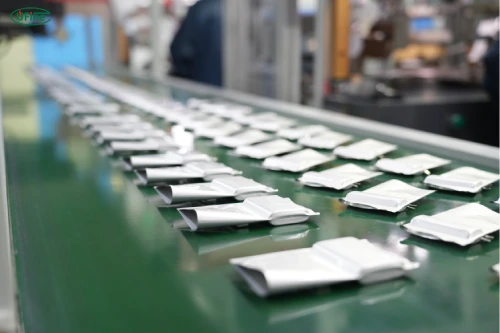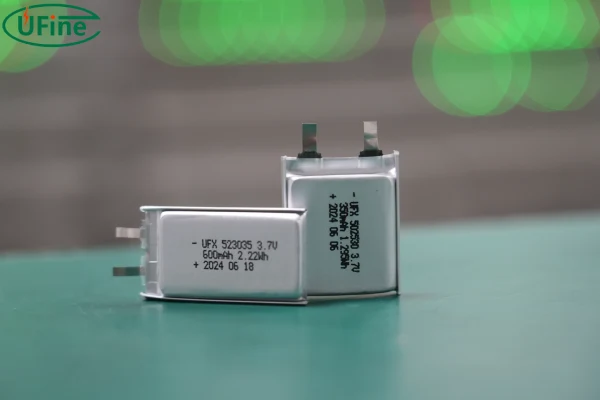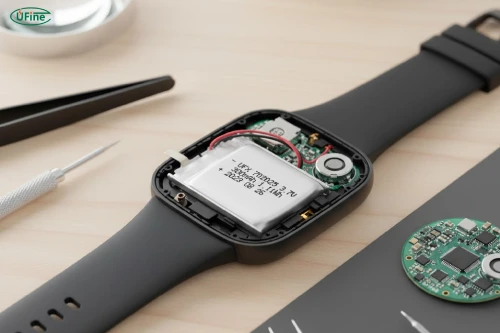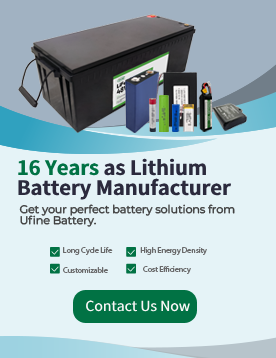
- Part 1. What is a 3.7V lithium battery?
- Part 2. Common types of 3.7V lithium batteries
- Part 3. How long does a 3.7V lithium battery last?
- Part 4. Key factors that affect 3.7V battery lifespan
- Part 5. How to extend the lifespan of a 3.7V rechargeable battery
- Part 6. Applications of 3.7V lithium batteries
- Part 7. 3.7V vs other common battery voltages
- Part 8. Signs of a deteriorating 3.7V battery
- Part 9. Recycling and disposal
- Part 10. Conclusion
- Part 11. FAQs
Lithium-ion batteries have become the backbone of modern portable power — from smartphones and laptops to drones, power tools, and electric vehicles. Among these, the 3.7 V lithium battery is one of the most widely used rechargeable power sources, known for its high energy density, stable performance, and long cycle life.
But how long do 3.7 V lithium batteries actually last? And what can you do to extend their lifespan?
Let’s explore everything you need to know — from battery chemistry and applications to charging and maintenance tips.
Part 1. What is a 3.7V lithium battery?
A 3.7 V lithium battery typically refers to a single lithium-ion or lithium-polymer cell with a nominal voltage of 3.6–3.7 V. These batteries are rechargeable and commonly used in portable electronics because they offer an excellent balance between power, weight, and energy capacity.
The voltage of 3.7 V represents the average working voltage — a fully charged cell usually reaches about 4.2 V, while it discharges down to 3.0 V–2.8 V depending on the protection circuit and application.
At Ufine Battery, we design and manufacture custom 3.7 V lithium batteries in various chemistries, capacities, and sizes — including lithium-ion (Li-ion), lithium-polymer (Li-poly), LiFePO4, and high-rate discharge cells for drones, wearables, tools, and more.
Part 2. Common types of 3.7V lithium batteries
| Battery Type | Nominal Voltage | Rechargeable | Typical Use |
|---|---|---|---|
| Lithium-ion (Li-ion) | 3.6 – 3.7 V | ✅ Yes | Laptops, power banks, flashlights |
| Lithium-polymer (Li-poly) | 3.7 V | ✅ Yes | Drones, RC models, wearables |
| LiFePO4 (special type) | 3.2 V (close alternative) | ✅ Yes | Energy storage, EVs, solar systems |
| Lithium-metal | 3.0 V | ❌ No | Non-rechargeable cameras, sensors |
Most 3.7 V batteries are rechargeable lithium-ion or lithium-polymer cells, while lithium-metal cells are single-use and not rechargeable.
Part 3. How long does a 3.7V lithium battery last?
On average, a 3.7 V lithium-ion battery lasts between 2 – 5 years or around 300 – 500 charge cycles before noticeable capacity degradation occurs.
Under optimal usage and charging conditions, high-quality cells can even reach 800–1,000 cycles.
Typical Runtime per Charge
How long a 3.7 V rechargeable battery lasts per charge depends on its capacity (mAh) and the power consumption of your device:
| Battery Capacity | Approx. Runtime | Example Application |
|---|---|---|
| 500 mAh | 2 – 3 hours | Bluetooth headset, wearable |
| 2000 mAh | 5 – 10 hours | Portable fan, flashlight |
| 5000 mAh | 10 – 20 hours | Tablet, power bank |
Part 4. Key factors that affect 3.7V battery lifespan

- Charge Cycles – Each full discharge and recharge counts as one cycle. The more cycles, the more the battery ages. Partial charging (e.g. 20 – 80%) helps prolong life.
- Temperature – Heat is the biggest enemy. High temperature accelerates chemical degradation; extremely cold conditions reduce performance.
- Depth of Discharge (DoD) – Avoid fully draining the battery. Keeping it between 20%–80% capacity maximizes longevity.
- Storage Conditions – Store around 50% charge in a cool, dry environment. Avoid storing when fully charged or completely depleted.
- Usage Intensity – High-drain devices or continuous heavy use will shorten battery life faster than moderate use.
Ufine Tip: For custom industrial projects, Ufine can tailor battery parameters — such as discharge rate, temperature tolerance, and capacity — to match your device’s real-world operating environment, ensuring maximum lifespan and performance stability.
Part 5. How to extend the lifespan of a 3.7V rechargeable battery
Here are a few expert recommendations from Ufine Battery engineers:
- Avoid full discharges. Recharge before the level drops below 20%.
- Keep it cool. Charge and store batteries in a moderate temperature range (15 °C–25 °C).
- Use a proper charger. Over-voltage or low-quality chargers can shorten lifespan.
- Store at half charge. For long-term storage, keep the battery at 40–60% SOC (state of charge).
- Cycle regularly. Even unused batteries degrade; use them at least every few months.
Part 6. Applications of 3.7V lithium batteries
3.7 V lithium-ion cells are extremely versatile and used in countless devices:
- Smartphones & tablets – compact energy source for daily electronics
- Power banks – consistent power output and long cycle life
- Electric tools & toys – stable voltage and high current discharge
- Wearable devices – lightweight and flexible Li-polymer cells
- Medical equipment, sensors, and IoT devices – reliable backup power
As a custom lithium battery manufacturer, Ufine Battery supports OEM and ODM projects worldwide. We provide customized 3.7 V rechargeable battery packs in various shapes, voltages, and capacities to fit your specific design and performance needs.
Part 7. 3.7V vs other common battery voltages
| Battery Type | Nominal Voltage | Rechargeable | Notes |
|---|---|---|---|
| AA Alkaline Battery | 1.5 V | ❌ | Lower energy density; single-use |
| NiMH Rechargeable AA | 1.2 V | ✅ | Lower voltage, less capacity |
| 3.7 V Lithium-Ion | 3.7 V | ✅ | Higher capacity, lighter weight |
| 9 V Battery | 9 V | Available in both types | Used in detectors, instruments |
Thus, 3.7 V lithium batteries offer a superior balance between energy density and size — making them the most efficient choice for compact, high-performance devices.
Part 8. Signs of a deteriorating 3.7V battery
Watch for these warning signs to know when it’s time to replace your battery:
- Shorter runtime than usual
- Overheating during charge or discharge
- Swelling or bulging casing
- Slower charging speed
- Voltage drop under load
If you experience any of these issues, stop using the battery immediately and contact a professional supplier for safe replacement options.
Part 9. Recycling and disposal
Never throw lithium batteries into household waste. They contain active materials that can cause fire or pollution if mishandled.
Bring used batteries to certified recycling points or send them back through professional collection programs.
Part 10. Conclusion
The 3.7 V lithium battery is a compact, powerful, and reliable energy source that powers today’s mobile world.
Its lifespan typically ranges from 2 – 5 years, but with the right care — proper charging, moderate temperature, and quality manufacturing — it can last even longer.
At Ufine Battery, we specialize in custom lithium battery solutions including 3.7 V lithium-ion, Li-polymer, 18650, LiFePO4, ultra-thin, and high-rate batteries.
If you need a reliable custom battery partner for your project, contact Ufine Battery to get high-performance, safe, and long-life battery solutions tailored to your needs.
Part 11. FAQs
Are all 3.7 V lithium batteries rechargeable?
Not all. Most 3.7 V lithium-ion and lithium-polymer cells are rechargeable, but lithium-metal versions (often labeled CR type) are non-rechargeable.
How many charge cycles can a 3.7 V lithium battery go through?
Typically 300 – 500 cycles. With proper care and moderate temperature, premium-grade cells can reach 800 – 1,000 cycles.
Can I replace a 1.5 V AA battery with a 3.7 V lithium cell?
No, 3.7 V lithium cells output much higher voltage than standard AA batteries and may damage devices not designed for lithium power. Use only compatible replacements.
How should I store a 3.7 V rechargeable battery long-term?
Keep it around 50% charge in a cool, dry place. Avoid high humidity and heat sources.
Related Tags:
More Articles

Battery Load Test: A Comprehensive Guide
Step-by-step battery load test guide for car, solar & industrial use. Learn how to load test a battery, interpret voltage charts, and avoid common mistakes.
The Comprehensive Guide to Battery Balancing and Battery Balancer
Discover how battery balancers improve lithium battery performance, lifespan, and safety. Learn types, functions, and tips to choose the right balancer.
What Is the Best Voltage for a Chainsaw Battery?
Compare 12V-80V chainsaw batteries for light pruning, medium firewood, and professional cutting. See best battery chainsaw with runtime charts and safety tips.
Lithium VS. Alkaline Batteries: A Comprehensive Comparison
Lithium batteries last 3–7× longer than alkaline and perform better in cold weather. Compare lifespan, cost, safety, and best uses to choose the right battery.
Comparing Lithium-Sulfur and Lithium-Ion Batteries: Which is Right for You?
Compare lithium-sulfur (Li-S) and lithium-ion batteries on energy, lifespan, cost, safety, and applications. Best choice for drones, EVs, and electronics.




